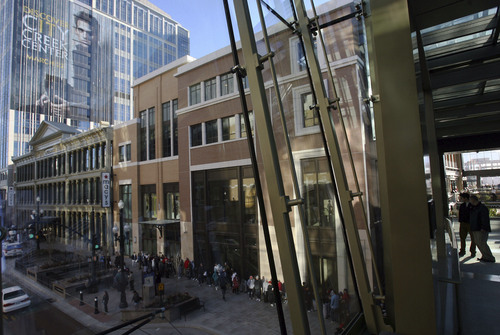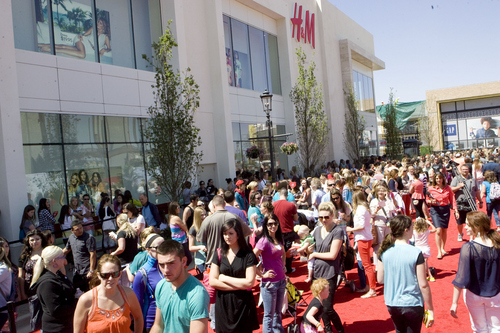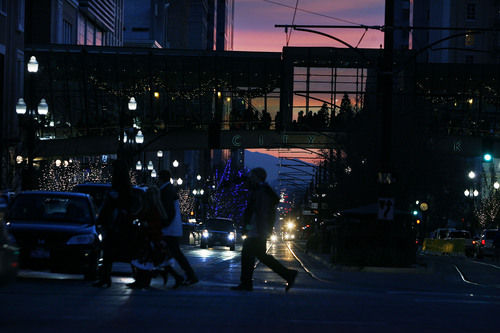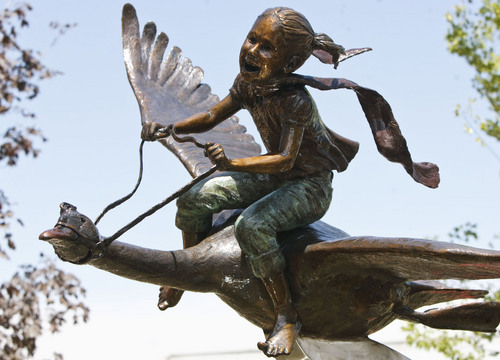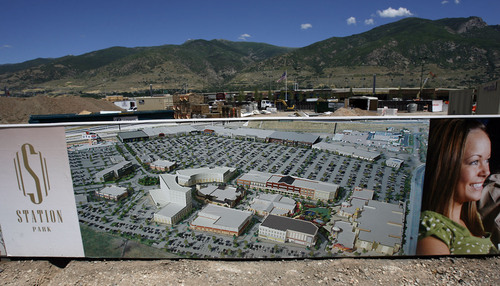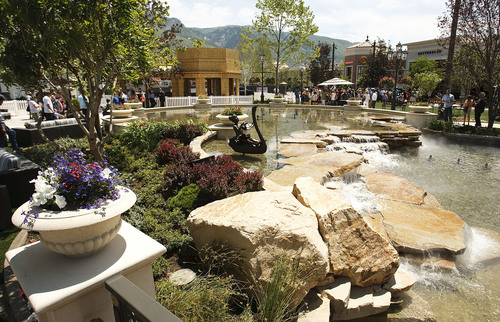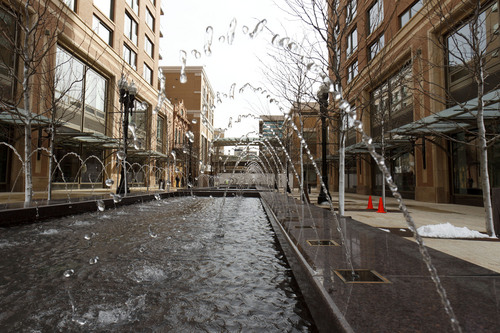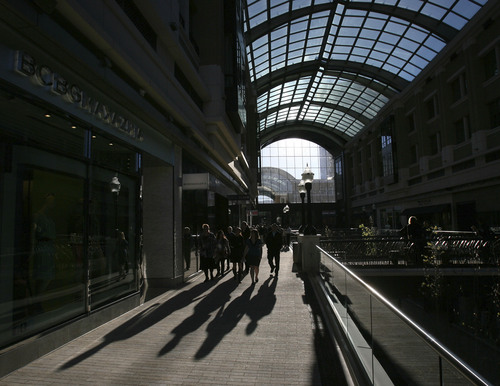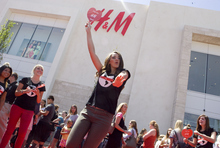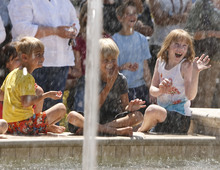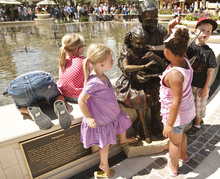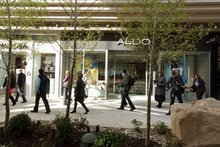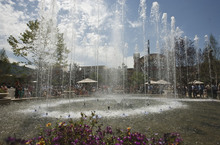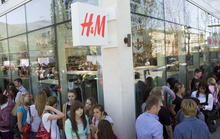This is an archived article that was published on sltrib.com in 2013, and information in the article may be outdated. It is provided only for personal research purposes and may not be reprinted.
Once a week, Jazmin Gonzalez of Brigham City makes the one-hour trek south just to go to her favorite shopping mall in Salt Lake City. That's how much she adores the new City Creek Center nestled between 100 and 200 South on Main Street.
"My happy place is there — the Disney Store," she said. "I love the feel of that mall. It's very pleasing."
Gonzalez could easily go to a number of malls that are much closer to her, but her willingness to keep driving to City Creek just demonstrates the love and loyalty that some shoppers have for their favorite malls.
Yet while the owners and developers of City Creek were getting all the attention last year for their luxurious one-of-a-kind open-air shopping center — partly due to its partnership with The Church of Jesus Christ of Latter-day Saints, which owns the property it sits on — a similarly ambitious open-air mall already was in the works just 30 minutes north of there in Farmington.
Station Park, a sprawling 62-acre center just west of the Lagoon amusement park, is nearly three times the size of City Creek in area, but it never attracted the same pomp and circumstance as City Creek did when the latter opened its doors in the spring of 2012. Station Park — which is still under construction and has three-quarters of its occupancy filled by retailers so far (leases for 93 percent of the mall have been signed) — first opened in July 2011 and is expected to be completed by fall of next year.
It may not have a gigantic retractable roof, a winding 1,200-foot creek running through its property, or the state's first Tiffany's jewelry store like City Creek has, but Station Park does have some of the same high-end amenities as City Creek, such as a multi-million-dollar computerized fountain and a much sought-after Apple Store.
Both malls also have plans for mixed-use properties. City Creek now has about 800 condominiums as well as office space on the property while Station Park will have a 125-room hotel by the end of next year and 125,000 square-feet of office space.
Station Park also can boast some important features that City Creek doesn't have — namely, state-of-the-art movie theaters through Cinemark, a martini bar, and most noticeably, the fact that it's open on Sundays. Because of its partnership with the Mormon Church, City Creek's retail stores are closed on Sundays while the restaurants remain open.
Despite that, the decision to include theaters and Sunday operations have not had an adverse affect, said City Creek General Manager Linda Wardell.
"It's exactly what we thought it would be," she said of the mall's plans coming to fruition. "Clearly, success speaks for itself. Clearly, retailers are clamoring to be a part of City Creek Center."
Open-air malls have been growing in popularity, said Fred Bruning, CEO of El Secondo, Calif.-based CenterCal Properties, which owns and operates Station Park, partly because they can offer new entertainment options enclosed malls can't. They also can be less expensive to operate with lower utility costs in heating and air conditioning.
There are at least 685 "super-regional malls" that offer anchor stores, entertainment options, and range from 60 to 120 acres (though it's uncertain how many are open-air), according to the International Council of Shopping Centers. Open-air malls have become a popular shopping option because they offer a wider variety of amenities, said the council's industry research director, Jean Lambert.
"They have to offer something different — more restaurants, all the entertainment, the retailers are more integrated with online, the food courts are improving," he said. "The offerings are different from what they were 10 years ago."
While both Station Park and City Creek are the state's newest open-air malls with similar features, they are very different, too. City Creek Center is an urban mall with unique high-priced stores such as Tiffany's and Porsche Design, while Station Park is situated in property next to tracts of homes and open real estate.
Bruning likens City Creek to a showpiece for the world, while his mall is a showpiece for the community. He considers Station Park a more quaint shopping experience, as if you're "in the middle of a Hallmark holiday postcard."
"It's a feeling of grandeur with City Creek," he said. "But we wanted to make it [Station Park] a feeling of community, a feeling where customers feel like this is their new living room or city park."
While Bruning sees both malls as shopping destinations that complement each other, City Creek's Wardell still considers Station Park a competitor.
"We have a large market area of about 250 miles around the center," she said. "We consider a lot of retail projects to be competitors for us."
One of those projects that's clearly in City Creek's sights is The Gateway next to Energy Solutions Arena, which has been heavily affected by City Creek. Since it opened, City Creek has wooed more than a dozen retailers, including the valuable Apple Store, away from the Gateway. As a result, the Gateway's taxable sales for the last nine months of 2012 were $40 million less than the same period the year before.
While it still might be too early to tell for Station Park since nearly half of the mall is still under construction, City Creek has so far been a resounding success. In its first nine months, the mall generated $200 million taxable sales, according to data from the Utah State Tax Commission. And so far this year, sales will reach record numbers, according to Jason Mathis, executive director of Salt Lake City's Downtown Alliance.
"It has definitely secured Salt Lake as a premiere shopping destination," he said.
Sales numbers aside, nothing at City Creek will lure Layton shopper Kris Baker. She has never gone to City Creek and says she never will.
"I just have a problem with some of the philosophies of their ownership and because they're closed on Sundays," she said. "I believe that if you're going to serve the public, you should be open to everyone."
Instead, she likes shopping at Station Park and believes it offers a different vibe than other shopping malls.
"They're open any day we want to go," she said. "It's just a completely different culture. I'm just glad Station Park is closer to us."
Whether it's for the refined urban flair of City Creek Center or the more cozy, traditional atmosphere of Station Park, Utah shoppers have a clear choice of where they can spend their holiday dollars this year.
Twitter: @ohmytech
Google+: +Vincent Horiuchi —
Comparing open-air malls
Two of Utah's newest open-air malls opened within a year of each other, Station Park in Farmington and City Creek Center in Salt Lake City. Here's a breakdown of each.
Station Park
(900 W. Clark Lane, Farmington)
Mall opened • July 2011.
Owned and managed by • El Segundo, Calif.-based CenterCal Properties.
Number of stores • 48. Thirty to 40 additional stores coming by the end of next year.
Number of restaurants • 17.
Total acreage • 62.
Anchor stores • Cinemark theaters, Harmons, H&M, Old Navy.
Percent of center that is occupied • 75 percent.
Other buildings • 150,000 square feet of office space. Will feature a 125-room hotel to open fall 2014.
Exclusive stores • Some of the stores and restaurants that were either first in the area or state when they opened include Marshall's, Gordman's, and Zumiez, soon-to-open Republic of Couture, ParkStone Wood Kitchen, Twigs Bistro & Martini Bar, Johnny Rockets, Tilly's, Go Lite, and IT'SUGAR
Unique features • State-of-the-art fountain in the center courtyard co-created by the same company that designed the "World of Color" water show at Disneyland. Six bronze sculptures created by artist Brian Keith. Children's playground in the Village Park. Four fire pits. Hand-selected 40- to 50-foot sycamores and maple trees from Canada.
City Creek Center
(50 S. Main St., Salt Lake City)
Mall opened • March 2012.
Owned and managed by • Bloomfield Hills, Mich.-based The Taubman Company.
Number of stores • 112.
Number of restaurants • 17.
Total acreage • 23.
Anchor stores • Nordstrom's and Macy's.
Percent of center that is occupied • 98 percent.
Other buildings • About 800 condominiums and six office buildings.
Exclusive stores • Alex & Ani, Free People, Tiffany & Co. Michael Kors, BCBGMAZAZRIA, Bose, Brooks Brothers/Brooks Brothers Women, Coach, Cotton On, The Limited, L'Occitane, Love Culture, N3L Optics, Papyrus, Porsche Design, Swarovski, Tumi, HUGO BOSS, Utah Woolen Mills, Rolex, Pandora, Albion, Allen Edmonds, RUUM, Microsoft, Steve Madden, Papyrus, West Elm, Restoration Hardware, Illume, Anthropologie, Salomon, Albion, Athleta, True Religion Brand Jeans
Unique features • A retractable glass roof which is the first for such a mall in the country, a creek that runs 1,200 feet through the property, choreographed fire fountains, and a pedestrian skybridge over Main Street.


